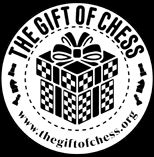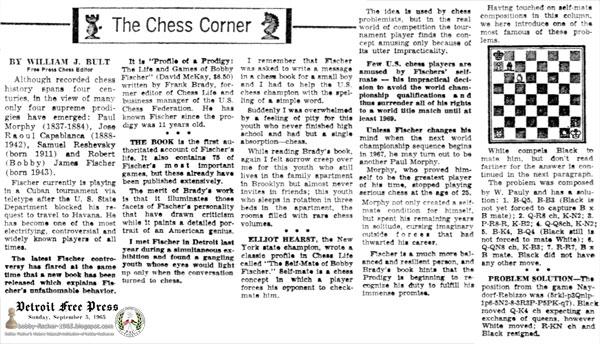Detroit Free Press Detroit, Michigan Sunday, September 05, 1965 - Page 16
The Self-Checkmate
Although recorded chess history spans four centuries, in the view of many only four supreme prodigies have emerged: Paul Morphy (1837-1884), Jose Raoul Capablanca, (1888-1942), Samuel Reshevsky (born 1911) and Robert (Bobby) James Fischer (born 1943).
Fischer currently is playing in a Cuban tournament via teletype after the U. S. State Department blocked his request to travel to Havana. He has become one of the most electrifying, controversial and widely known players of all times.
I met Fischer in Detroit last year during a simultaneous exhibition and found a gangling youth whose eyes would light up only when the conversation turned to chess.
I remember that Fischer was asked to write a message in a chess book for a small boy and I had to help the chess champion with the spelling of a simple word.
Suddenly I was overwhelmed by a feeling of pity for this youth who never finished high school and had but a single absorption-chess. While reading Brady's book, again I felt sorrow creep over me for this youth who still lives in the family apartment in Brooklyn but almost never invites in friends… the rooms filled with rare chess volumes.
Elliot Hearst, the New York state champion, wrote a classic profile in Chess Life called “The Self-Mate of Bobby Fischer.” Self-mate is a chess concept in which a player forces his opponent to check-mate him.
The idea is used by chess problemists, but in the real world of competition the tournament player finds the concept amusing only because of its utter impracticality.
Few U.S. chess players are amused by Fischer's self-mate - his impractical decision to avoid the world championship qualifications and thus surrender all of his rights to a world title match until at least 1969.
Unless Fischer changes his mind when the next world championship sequence begins in 1967, he may turn out to be another Paul Morphy.
Morphy, who proved himself to be the greatest player of his time, stopped playing serious chess at the age of 25.
Morphy not only created a self-mate condition for himself, but spent his remaining years in solitude, cursing imaginary outside forces that had thwarted his career.
Fischer is a much more balanced and resilient person, and Brady's book hints that the Prodigy is beginning to recognize his duty to fulfill his immense promise.
Having touched on self-mate compositions in this column, we here introduce one of the most famous of these problems.
White compels Black to mate him, but don't read farther for the answer is continued in the next paragraph. The problem was composed by W. Pauly and has a solution…























